Vaiei Tupuna
Cora-Allan
Dalani Tanahy
Doron Semu
Hinatea Colombani
Liviana Qaranivalu
Nikau Hindin
Pauline Reynolds
Sarah Vaki
Sue Pearson
Sulieti Fieme'a Burrows
Tui Emma Gillies
'Uhila Moe Langi Nai
Te Pātaka Toi Adam Art Gallery in collaboration with Museum of New Zealand Te Papa Tongarewa
04 October – 15 December 2024
Vaiei Tupuna is an exhibition of contemporary tapa from across Moana Nui that brings together newly commissioned responses to taonga from the collections of Ngā Puhipuhi o Te Herenga Waka—Victoria University of Wellington Art Collection and The Museum of New Zealand Te Papa Tongarewa, alongside historic and contemporary artworks that acknowledge the tupuna and atua who activate this practice. Gifted by Sarah Vaki, elder and master tapa maker from Fatu Hiva in the Marquesas, the title of the exhibition translates as “heritage of our ancestors”. Vaiei Tupuna takes up these shared genealogies and histories of tapa to celebrate the vitality of the artform in the present, and to extend and build knowledge for the future. Hina, the atua of tapa makers, is present throughout Vaiei Tupuna.
Vaiei Tupuna both opens and closes with the figure of Poeatua. Painted in 1785, this portrait was one of the first images of an Indigenous woman of Moana Nui to circulate in Europe. An Ari’i from Ra'iātea, Poeatua is part of a matrilineal line that extends back to Hina. Poeatua’s presence here represents a commitment to rereading the past, restoring knowledge, honouring our tupuna and speaking their names.
The exhibition features three component parts:
Hala Kafa, 2024, is a new commission by ‘Uhila Moe Langi Nai, and the result of an earlier invitation from Te Pātaka Toi Adam Art Gallery to engage with a Tongan tapa, in its collection. Gifted to Te Herenga Waka—Victoria University of Wellington by the University of the South Pacific in 1999, this tapa known as a ngatu tāhina is notable for its ceremonial scale, which, at over 24 metres, wrapped the length of the gallery upon its display in 2023. Finding in the ngatu tāhina a kupesi pattern inherited from her grandmother, Nai has conceived of her response as an iteration of its original gift. In Tonga, to gift koloa is a sign of respect. Hala Kafa transposes the horizontal scale of the ngatu tāhina into six vertical lengths, and its hand-beaten kupesi into stylised, rhythmic forms, returning koloa to its original, anonymous makers.
‘Ahu: Ngā Wairua o Hina is the name of a wānanga held in Tahiti in late 2023, for which eleven tapa makers were invited by Te Papa to engage with and respond to a tapa sampler collated by bookseller Alexander Shaw in 1787. This wānanga was hosted by Te Fare Iamanaha Musée de Tahiti et des Îles. Over the course of the wānanga, artists Cora-Allan, Dalani Tanahy, Doron Semu, Hinatea Colombani, Liviana Qaranivalu, Nikau Hindin, Pauline Reynolds, Sarah Vaki, Sue Pearson, Sulieti Fieme’a Burrows and Tui Emma Gillies put together a portfolio of contemporary tapa. Each contributed their own imagining of a living relationship to the tapa in the sampler, producing three works that represented ideas of the past, present and future. The pieces were then brought together in two ‘bundles’, one returning to Te Papa and the other gifted to Te Fare Iamanaha. Installed throughout the Lower Chartwell Gallery, Te Papa’s bundle has been unpacked and displayed for the first time, shown with copies of Shaw’s tapa sampler from collections throughout Aotearoa.
Alongside these projects, Hina Sings… is an iterative collaboration between Pauline Reynolds and Sue Pearson, two of the artists who also attended the wānanga. It comprises ancestral tīputa and hei dedicated to Hina, as well as an example of 'ahufara tapa made from aute plants grown in Whakatāne. In the Kirk Gallery, Hina’s Granddaughters, 2022, is an immersive experience of poetry, song and moving image, and projects the film made by the artists with their children onto a screen of 'ahu. A collaboration between artists, makers, institutions, and curators, Vaiei Tupunua asserts the enduring wairua of tapa’s ancestors, and present and future practitioners.
Curated by Sophie Thorn and Rosalie Koko, Te Pātaka Toi; Isaac Te Awa and Rebecca Rice, Te Papa Tongarewa; and Nālani Wilson-Hokowhitu, Va'aomanū Pasifika.
Cora-Allan (Niue – Alofi, Liku; Aotearoa – Ngāpuhi, Ngāti Tumutumu) is a visual mixed-media artist. She was encouraged by her Niue grandparents to make hiapo – Niue bark cloth. Since then, Cora-Allan has helped the Niue community to connect with this once-dormant art form. She uses the materials of her ancestors such as the bark of ata (paper mulberry), and incorporates kāpia ink made from local sources. Her work has developed incorporating whenua pigments on her hiapo and remains firmly rooted in community. Cora-Allan has been the recipient of several awards including the Creative New Zealand Pacific Heritage Artist award in 2020, and an Arts Foundation Springboard Award in 2021, and has been an artist in residence at McCahon House, Mana Moana and Te Whare Residency in Wellington, all in 2021. Cora-Allan has exhibited internationally in Australia, Niue, England and Canada, as well as throughout Aotearoa. Recent exhibitions include: Aro Toi / Collection in Focus: A Gift, A Celebration, An Invitation, Te Pātaka Toi Adam Art Gallery, 2023; Encountering Aotearoa, Dunedin Public Art Gallery, 2023; and From Otītori Bay Rd, Te Uru Waitakere Contemporary Gallery, 2022.
Dalani Tanahy (Hawai’i) is an artist and maker of kapa, Hawaiian bark cloth. She is mostly self-taught, and started making kapa when the once-dormant art form was being revived. Tanahy is sustained by the process of kapa making – from growing wauke (paper mulberry) and making tools, to producing natural dyes, and beating the inner layer of wauke bark into a soft material. She has taught kapa making for 25 years and continues to create the art form of her ancestors in new ways. Tanahy's work has been exhibited by the Bishop Museum, Honolulu, the British Museum, and the National Museum of the American Indian, New York. She served as the inaugural 2018 Master Kumu for the Hawaiian-Pacific Studies program at University of Hawaiʻi – West Oʻahu. In 2015 Tanahy was awarded a Native Hawaiian Artist Fellowship by the Native Arts and Cultures Foundation and was the recipient of a Lifetime Achievement Award from the Polynesian Cultural Center.
Doron Semu (Sāmoa – Falelatai, Salelesi, Asau, Falelima; New Zealand European) is a Siapo maker of Sāmoan and palagi descent, hailing from the villages of Salelesi, Falelatai, Falelima and Asau. Based in Māngere, Tāmaki Makaurau, Semu has learned his practice under the guidance of Tufuga, Fa'apito Lesatele of Vailoa, Palauli. Through his work, Semu tells stories of MVPFAFF+ (Mahu, Vaka Sa Lewa Lewa, Palopa, Fa'afafaine, Akava'ine, Fakalaiti and Fakafafine) Rainbow Pasifika joy, with increased visibility and representation. Semu's practice is centred on creating safe spaces and opportunities for the MVPFAFF+ Rainbow Pasifika community to thrive and expand the community of diasporic Siapo makers in Aotearoa. He is the co-creator of Akanuanua, a television series exploring the lived realities of the MVPFAFF+ queer Pasifika community. Semu has run siapo-making workshops across Aotearoa including as a featured maker in Te Papa’s Toi Tuku Iho – Aute in 2022 and his work is held in the Pacific collection at Te Papa.
Hinatea Colombani (Te Ao Mā'ohi - Tahiti) is recognised by the French Polynesian Traditional Crafts Department as a master tapa-maker. In 2008, she set up her own dance school before extending her teaching to other Polynesian arts. In 2016 she co-founded the 'Arioi Cultural Centre with her partner Moeava Meder. Colombani and Meder have dedicated their lives to working with tapa, perfecting their skills through books, observation and, above all, experimentation. Colombani’s practice is marked by a full dedication to the complete process: planting, harvesting, making tools, beating the bark, preparing natural dyes, painting on the tapa and pursuing literary and experimental research about tapa.
Liviana Qaranivalu (Fiji – Vatulele) was born and raised on the small island of Vatulele, Fiji. She comes from a long unbroken line of Fijian masi makers. Qaranivalu, like all the women in her village, has been making tapa since childhood and even today between the hours of 8am and 6pm local time - the sound of the tapa beater against anvil permeates her village. Qaranivalu isn't just a tapa maker, as the founder of 'Vatulele Tapa Flee' her business supports and enables the practice of makers across the whole Pacific through the supply of tapa bark and tools to communities where these resources are rare or being established.
Nikau Hindin (Aotearoa – Ngāi Tūpoto, Te Rarawa, Ngāpuhi) is a bark cloth maker who works with aute (paper mulberry) and natural earth pigments. Hindin holds a BFA (Honours) and BA conjoint from The University of Auckland, as well as an MFA from The University of Hawaii and a Masters of Creative Practice from Toihoukura, Eastern Institute of Technology. She is dedicated to reinvigorating the art of aute in Aotearoa. Her work spans the process of making bark cloth, from growing and harvesting, to processing the inner bark, and creating a fine white cloth, and is inspired by Māori astronomy and concepts of time and space. Recent exhibitions include 24th Biennale of Sydney, 2024; 35th Bienal de São Paulo, 2023; O Quilombismo, House of World Cultures, Berlin, 2023; Manu Aute: Rere Runga Hau, Season Gallery, Auckland, 2022; Still Alive, Aichi Triennale, Tokoname, Japan, 2022; Walls to Live Behind, Rooms to Own, Auckland Art Gallery, 2022; Kōkōrangi ki Kōkōwai, Hastings City Gallery, 2019–22; Kathmandu Triennale 2077, 2020 and Koloa: Women, Art, and Technology at Para Site, Hong Kong. Recent publications include 'Te Uru Aute' (co-edited with Rongomai Grbic-Hoskins, 2022). Hindin was also a contributor to the 2019 publication ‘Crafting Aotearoa: A Cultural History of Making in New Zealand and the Wider Moana Oceania’, edited by Karl Chitham, Kolokesa Māhina-Tuai and Damian Skinner.
Dr Pauline Reynolds (Norfolk Island – Pitcairn, Tahitian descent) is a Pacific historian, writer and artist who lives on Norfolk Island. She is invested in how islanders can re-imagine and re-construct their own stories/histories. She collaborates with museum curatorial teams internationally and was recently commissioned to replicate the barkcloth components of a Tahitian chief mourner’s regalia for the reopening of the Perth (Scotland) Museum, which is on display in their Pacific gallery. Her tapa creations are held in museum collections in Aotearoa, Tahiti, the UK (Perth, London and Cambridge) and Norfolk Island. Reynolds’s PhD by Creative Practice includes the novel Hina’s Daughters, and she has written extensively about tapa from Pitcairn and Tahiti, including the publication Pitcairn Tapa ’Ahu no Hitiaurevareva. She is currently co-writing a book about the ten ’Ahu Heva Tūpāpa’u (Tahitian Chief Mourner’s regalia) collected by Cook. An Adjunct Fellow with the Department of Critical Indigenous Studies at Macquarie University, Australia, Reynolds is a founding member of the ’Ahu Sistas collective.
Sarah Vaki (Te Ao Mā'ohi – Fatu Hiva) was born in 1948 and lives in Omoa on the island of Fatu Iva in Te Henua Enata (Marquesas Islands). From 1967 to 2006 she worked as a schoolteacher. Vaki learnt the art of tapa making from her grandmother. Deeply committed to the preservation and transmission of her culture, she was elected academician by the people of Fatu Iva in 2000 and is a member of the commission in charge of the lexicon of the Marquesan language. She was former president of the craft and cultural association Te Heikua o te Vehine and vice-president of the Marquesan cultural federation Motu Haka. She is an ambassador of culture for her island and is committed to its transmission and preservation.
Sue Pearson (Norfolk Island – Pitcairn, Tahitian descent) is a Norfolk Island based multi-disciplinary artist and member of the ’Ahu Sistas, a collective of four vahine who descend from Pitcairn Island. For 18 years, they have researched and protected the ancestral knowledge of 'ahu (Pitcairn bark cloth), reclaimed the practice of tapa making within the Pitcairn and Norfolk Island people and created artistic expressions to honour their tupuna wahine. Pearson cultivated and harvested aute (paper mulberry) in Whakatāne for 10 years and is a founding member of Tapa Moana Nui, a Pasifika group who gather to make tapa. As a descendant of the mutineers of the HMS Bounty and the Tahitian women who settled on Pitcairn Island, Sue’s work often enquires into and interoperates her Norfolk/Te-Moana-Nui-a-Hiwa heritage, identity and politics. Pearson’s work is housed in collections throughout Aotearoa, the Pacific, USA, and Great Britain.
Sulieti Fieme’a Burrows (Tonga – Falevai, Vava’u) MNZM, is an artist and expert in the creation of tapa cloth born in Tonga in 1951. She moved to New Zealand in the 1970s, bringing her knowledge of ngatu, the Tongan form of tapa, and other traditional Tongan crafts. Burrows is also a passionate advocate for the revival and continuation of this traditional Tongan artform. Together with her daughter Tui Emma Gillies, Burrows has presented workshops at institutions across the world including the University of Hawai‘i, the University of Vienna, and the Museum of the Americas in Madrid, and was the subject of Gillies documentary film, Vava’u ‘Falavai Flava. Burrows has many works acquired by major public institutions including The Royal Academy of Art, London and The National Gallery of Victoria, Melbourne. She has exhibited her work internationally and in Aotearoa. Recent exhibitions include The Last Kai, Tautai Pacific Contemporary Arts Trust Gallery, Auckland, 2023; Under the Same La'ā, Corban Estate Arts Centre, 2019; and Falevai Flava, Mangere Arts Centre, 2018.
Tui Emma Gillies (Tonga – Falevai, Vava'u) is a Tongan New Zealand artist who preserves her family’s ancestral DNA through the sacred ritual of tapa making. Her work mixes contemporary with traditional and can be challenging and controversial, but always with respect to the ancestral roots of the medium. Gillies’ work is held in museum and gallery collections internationally including The National Maritime Museum, Auckland War Memorial Museum, GRASSI museum in Germany, National Gallery of Victory in Melbourne and Pick Museum of Anthropology in Illinois, USA. In 2018 Gillies received the Creative New Zealand Pacific Heritage Art Award, and with her mother, Sulieti Fieme’a Burrows, has helped revive tapa art in their home village of Falevai, Vava'u where it had vanished decades earlier. Earlier in 2024 Gillies was Resident Artist of the Macmillan Brown Center for Pacific Studies, University of Canterbury, culminating in her first solo exhibition View from the Deep, Fibre Gallery, Christchurch.
‘Uhila Moe Langi Nai is a multi-disciplinary artist with roots in Auckland and Pelehake Tonga. Nai completed a Bachelor of Visual Arts at AUT in 2018, followed by a Master of Visual Arts in 2020. She has been the recipient of a number of awards including the Art Foundation Te Tumu Toi Springboard Award, the inaugural BC Collective Award, Auckland Art Gallery Award for High Achievement and the Vā Moana Pacific Spaces Postgraduate Award. In 2023 she undertook a residency in Taitung, Taiwan. Solo and group exhibitions include Manatu-Melie, Mangere Art Centre, 2024; Malu ‘a Fonua/7 am, Paper Anniversary, 2023; Motherland Homeland, HOEA! Whare Whakaatu Toi and Enjoy Contemporary Artspace, Te-Whanganui-a-Tara, 2023; Fepotalanoa′aki pea mo ′ekufangakui: In conversation with my great-great-great-grannies, Blue Oyster Art Project Space, Ōtepoti Dunedin, 2022; and Matrilineal, Depot Artspace, Tāmaki Makaurau Auckland, 2022. Nai is currently a PhD candidate at AUT and based in Tāmaki Makaurau Auckland.
Dr Nālani Wilson-Hokowhitu is a Kanaka ʻŌiwi, Native Hawaiian, artist, documentary filmmaker and Lecturer in Va’aomānu Pasifika, Pacific Studies at Te Herenga Waka—Victoria University of Wellington. Her scholarship and creative practice engage moʻokūʻauhau, genealogical connections to the natural world, Mana Wāhine, Indigenous and Pacific feminisms, as well as epistemologies and ontologies that inform critical, innovative and transformative futurities. Her research, curation, documentaries, and visual art add to the growing body of knowledge expressed by Kānaka ʻŌiwi, Moana Nui, and Indigenous peoples working at the interface of social justice and environmental protection of our islands, earth, waterways, and oceans. Wilson-Hokowhitu is a recipient of a Royal Society of New Zealand Te Apārangi Marsden Fast-Start grant (2021-2024) focusing on retracing the storylines of Pacific women voyagers and navigators. She is the author of 'Moana Nui Rising' (2023, TCP 35:1); a featured artist in The Contemporary Pacific Journal (2022) and editor of 'The Past Before Us: Moʻokūʻauhau as Methodology' (2019) published by the University of Hawaiʻi Press.
Isaac Te Awa (Ngāpuhi, Kāti Māmoe, Kai Tahu, Waitaha) is an artist and Curator Modern & Contemporary Māori & Indigenous Art at Te Papa Tongarewa Museum of New Zealand. He has a diverse interest within te ao Māori and a passion for the reconnection of taonga Māori to people, place and community. He is an active practitioner and researcher of Māori weaving and carving with a special interest in the revitalisation and documentation of traditional technique, practice, and knowledge. Recently authored articles include ‘Encountering Aotearoa’, Bulletin, Christchurch Art Gallery Te Puna o Waiwhetu, 2024 and 'Poi: The Mesmerising Sound of Living Taonga'. Garland Magazine 2023. He Recently he co-edited the book 'Flora: Celebrating our Botanical World' (Te Papa press, 2023) and co-authored 'Aute and the Pacific' as a part of Lopesi, L. 'Pacific Arts Aotearoa' (Penguin Press 2023). His most recent exhibitions include Te Mata Tūroa o Papa / This Natural World and Hinakī: Contemplation of a Form for Te Papa in 2023, and Ko Wai Rā Te Manu? Wellington City Council, 2023.
Dr Rebecca Rice is Head of Art (Acting) at the Museum of New Zealand Te Papa Tongarewa. She is a curator and researcher dedicated to the study, interpretation and presentation of historical art in Aotearoa New Zealand. Her research is deeply collaborative, often with the intention of interrogating the colonial situations in which art was produced, exhibited and collected. Recent exhibitions and publications include Te Mata Kāwai Heke o Papa ӏ Arranging Nature which explored the relationship between art and natural history Te Papa, 2023, Hiahia whenua: Landscape and desire, Te Papa, 2022 and 'Flora: Celebrating our Botanical World' (Te Papa Press, 2023).
Sophie Thorn is a curator and writer based in Te Whanganui a Tara, Wellington. She holds a Master of Arts in Art History and Theory from the University of Canterbury (2010). She has held positions at the Canterbury Museum, Experience Wellington, and Te Manawa Museums Trust. She has been with Te Pātaka Toi Adam Art Gallery since 2014. Between September 2023 – October 2024 she has been on secondment to the role of Manutaki Director from her substantive position as Kaiwhakarākei Curator Collections. Thorn has an ongoing collaborative relationship with Professor Susan Ballard exploring an environmental humanities lens on Nga Puhipuhi o Te Herenga Waka—Victoria University Art Collection which has resulted in the exhibitions Listening Stones Jumping Rocks, 2021, and Folded Memory, 2023. Recent exhibitions include Infrastructure: power, politics and imagination and The buildings notice me both 2024 at Te Pātaka Toi Adam Art Gallery.
Rosalie Koko (Ngāti Kahungunu, Olosega Amerika Sāmoa) is an emerging artist and curator. She completed her bachelor's degree in Māori Visual Arts through Te Pūtahi a Toi, Te Kunenga ki Pūrehuroa Massey University in 2023. She is deeply interested in the ways in which knowledge is embedded in the traditional arts of tangata whenua and tagata moana, and how this knowledge is carried into the future in adapted forms by contemporary art practitioners. In the past year she has been learning how to beat and paint tapa. Koko is the 2024 Pia Nahanaha Taonga, Adam Art Gallery Intern. Vaiei Tupuna has been the focus of her Internship.

Installation view, Vaiei Tupuna, Te Pātaka Toi Adam Art Gallery, Te Herenga Waka—Victoria University of Wellington, 2024. Photo: Ted Whitaker.
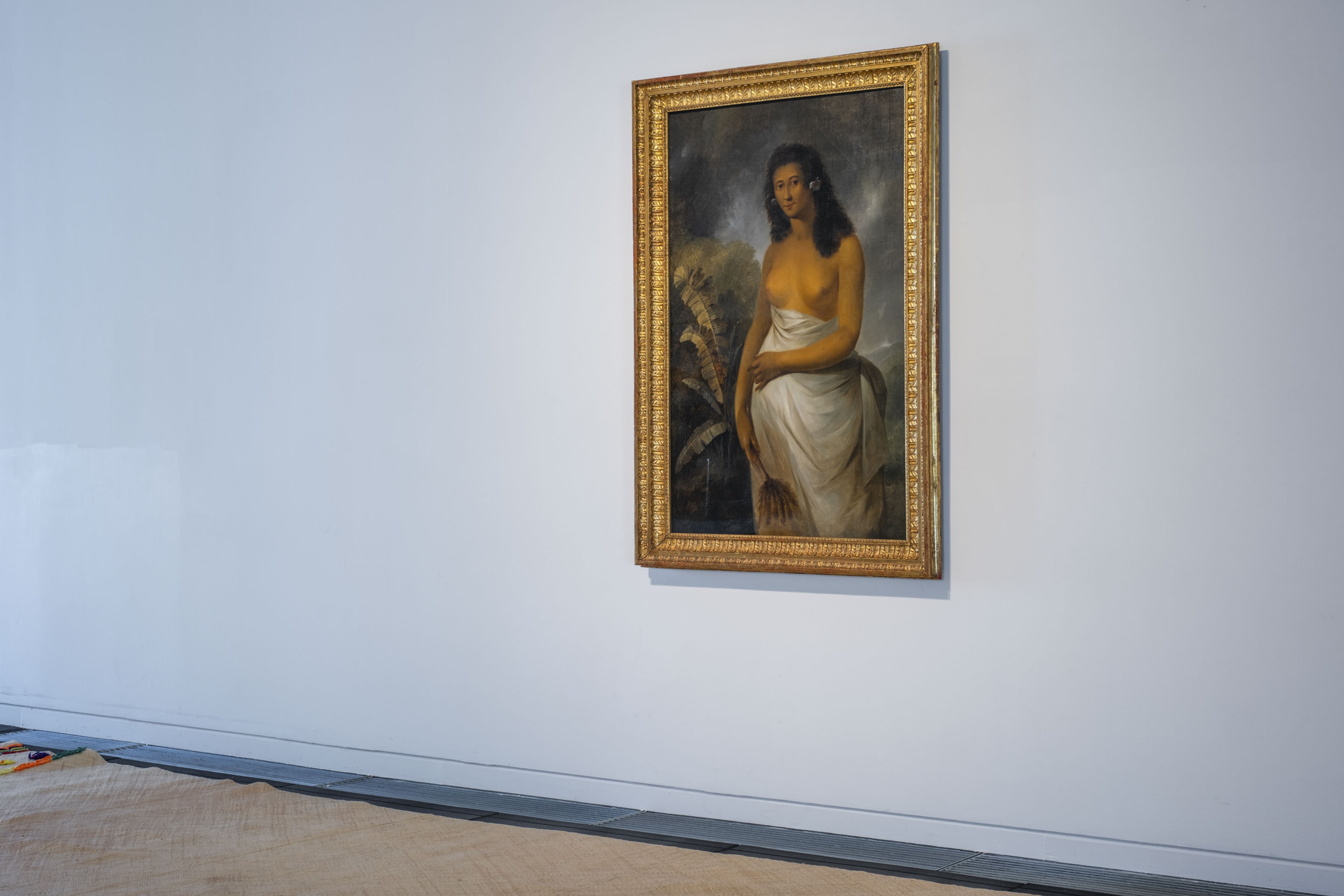
Installation view, Vaiei Tupuna, Te Pātaka Toi Adam Art Gallery, Te Herenga Waka—Victoria University of Wellington, 2024. Photo: Ted Whitaker.
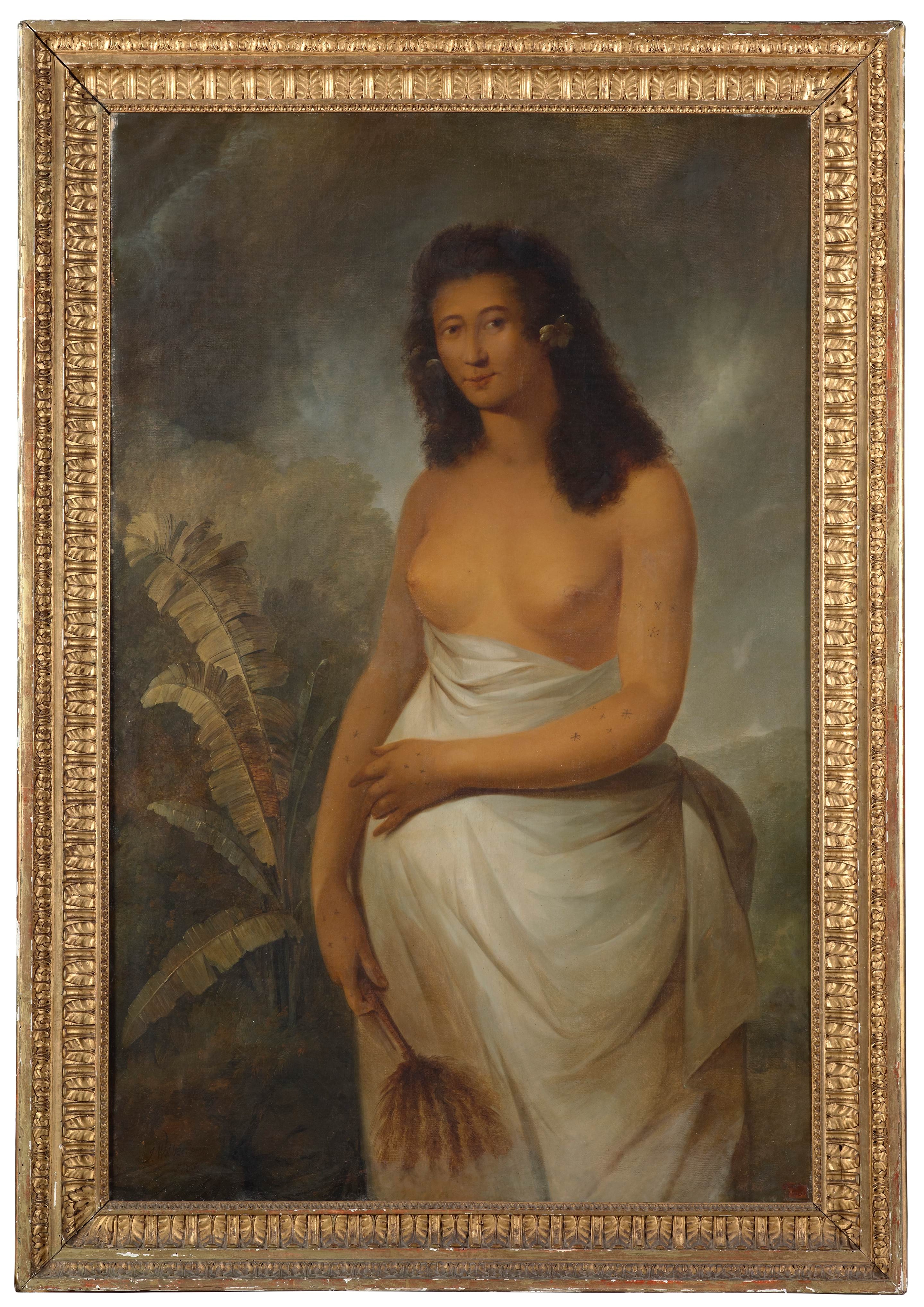
John Webber, Poedua [Poetua], daughter of Oreo, chief of Ulaietea, one of the Society Isles, 1785, oil on canvas, Collection of Museum of New Zealand Te Papa Tongarewa, purchased 2010.

Installation view, Vaiei Tupuna, Te Pātaka Toi Adam Art Gallery, Te Herenga Waka—Victoria University of Wellington, 2024. Photo: Ted Whitaker.

‘Uhila Moe Langi Nai, Hala Kafa, 2024, ink on pepa koka’anga, six parts of 900 × 4000mm. Courtesy of the artist. Installation view, Vaiei Tupuna, Te Pātaka Toi Adam Art Gallery, Te Herenga Waka—Victoria University of Wellington, 2024. Photo: Ted Whitaker.

‘Uhila Moe Langi Nai, Hala Kafa (detail), 2024, ink on pepa koka’anga, six parts of 900 × 4000mm. Courtesy of the artist. Installation view, Vaiei Tupuna, Te Pātaka Toi Adam Art Gallery, Te Herenga Waka—Victoria University of Wellington, 2024. Photo: Ted Whitaker.

‘Uhila Moe Langi Nai, Hala Kafa (detail), 2024, ink on pepa koka’anga, six parts of 900 × 4000mm. Courtesy of the artist. Installation view, Vaiei Tupuna, Te Pātaka Toi Adam Art Gallery, Te Herenga Waka—Victoria University of Wellington, 2024. Photo: Ted Whitaker.
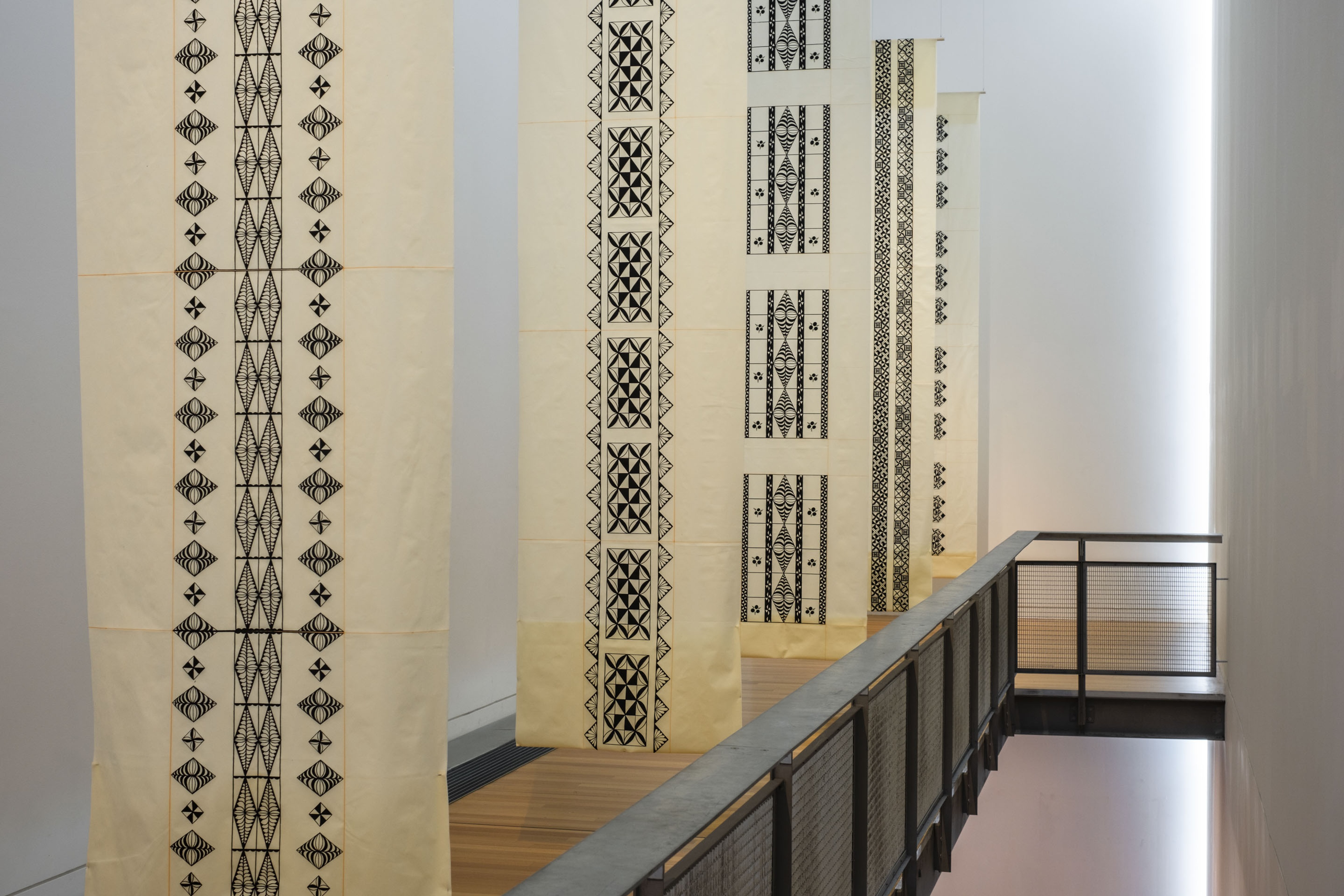
‘Uhila Moe Langi Nai, Hala Kafa (detail), 2024, ink on pepa koka’anga, six parts of 900 × 4000mm. Courtesy of the artist. Installation view, Vaiei Tupuna, Te Pātaka Toi Adam Art Gallery, Te Herenga Waka—Victoria University of Wellington, 2024. Photo: Ted Whitaker.

‘Uhila Moe Langi Nai, Hala Kafa (detail), 2024, ink on pepa koka’anga, six parts of 900 × 4000mm. Courtesy of the artist. Installation view, Vaiei Tupuna, Te Pātaka Toi Adam Art Gallery, Te Herenga Waka—Victoria University of Wellington, 2024. Photo: Ted Whitaker.

‘Uhila Moe Langi Nai, Hala Kafa (detail), 2024, ink on pepa koka’anga, six parts of 900 × 4000mm. Courtesy of the artist. Installation view, Vaiei Tupuna, Te Pātaka Toi Adam Art Gallery, Te Herenga Waka—Victoria University of Wellington, 2024. Photo: Ted Whitaker.

Sue Pearson, Awas Tupuna, 2022, aute, etching ink. Courtesy of the artist. Installation view, Hina Sings, Vaiei Tupuna, Te Pātaka Toi Adam Art Gallery, Te Herenga Waka—Victoria University of Wellington, 2024. Photo: Ted Whitaker.

Sue Pearson, Awas Tupuna, 2022, aute, etching ink. Courtesy of the artist. Installation view, Hina Sings, Vaiei Tupuna, Te Pātaka Toi Adam Art Gallery, Te Herenga Waka—Victoria University of Wellington, 2024. Photo: Ted Whitaker.
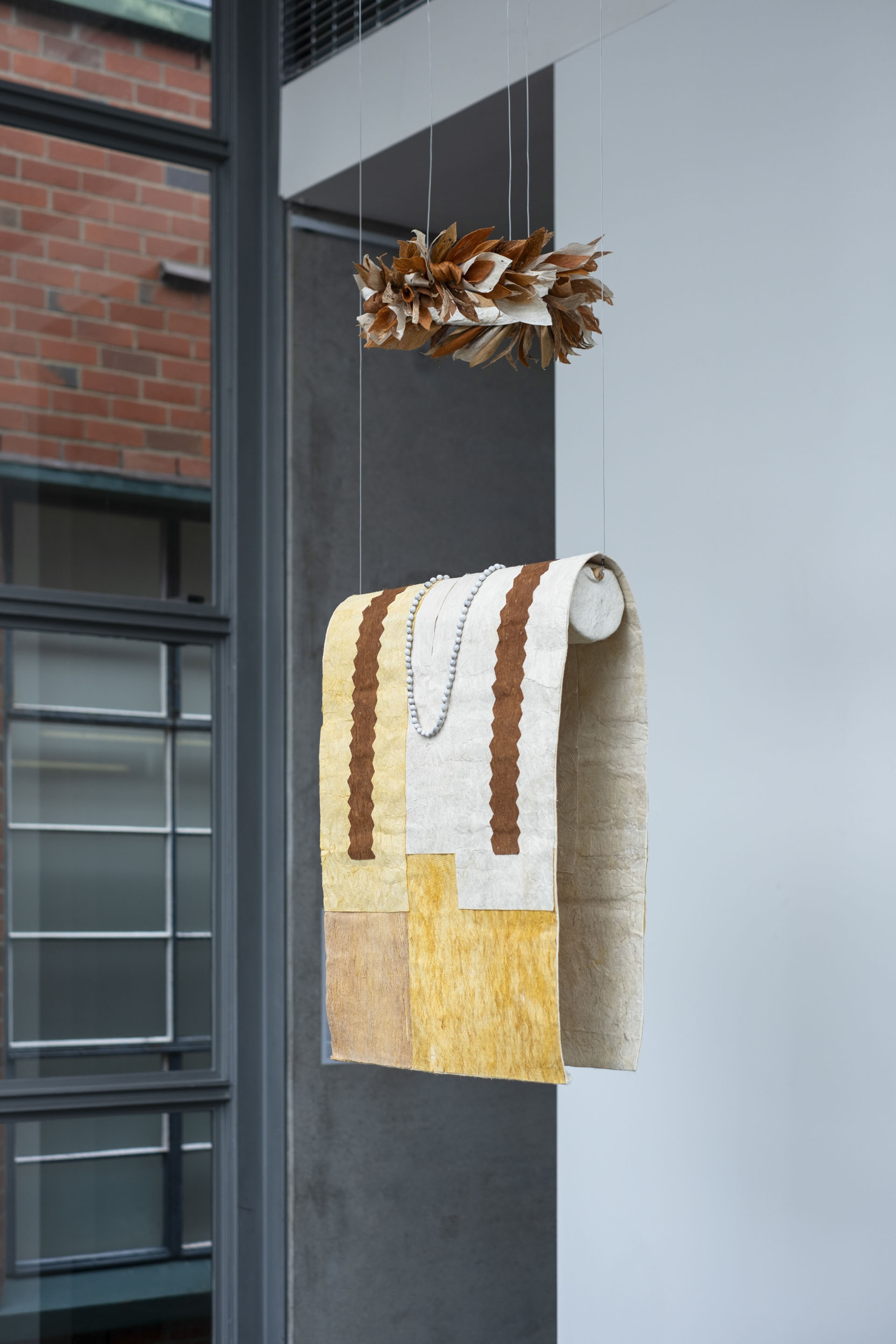
Pauline Reynolds, Te hei no Hina, 2024, woven and plaited ’ōrā (banyan); and My Grandmother is a Tīputa, 2022, aute (paper mulberry), ’uru (breadfruit), ’ōrā tapa dyed with turmeric and nono. Courtesy of the artist. Installation view, Hina Sings, Vaiei Tupuna, Te Pātaka Toi Adam Art Gallery, Te Herenga Waka—Victoria University of Wellington, 2024. Photo: Ted Whitaker.

Pauline Reynolds, Te hei no Hina, 2024, woven and plaited ’ōrā (banyan); and My Grandmother is a Tīputa, 2022, aute (paper mulberry), ’uru (breadfruit), ’ōrā tapa dyed with turmeric and nono. Courtesy of the artist. Installation view, Hina Sings, Vaiei Tupuna, Te Pātaka Toi Adam Art Gallery, Te Herenga Waka—Victoria University of Wellington, 2024. Photo: Ted Whitaker.

Pauline Reynolds, Te hei no Hina (detail), 2024, woven and plaited ’ōrā (banyan); and My Grandmother is a Tīputa, 2022, aute (paper mulberry), ’uru (breadfruit), ’ōrā tapa dyed with turmeric and nono. Courtesy of the artist. Installation view, Hina Sings, Vaiei Tupuna, Te Pātaka Toi Adam Art Gallery, Te Herenga Waka—Victoria University of Wellington, 2024. Photo: Ted Whitaker.

Pauline Reynolds and Sue Pearson, Hina’s Granddaughters, 2022, HD video with audio projected onto tapa cloth, 10 minutes, looped. Courtesy of the artists. Installation view, Hina Sings, Vaiei Tupuna, Te Pātaka Toi Adam Art Gallery, Te Herenga Waka—Victoria University of Wellington, 2024. Photo: Ted Whitaker.

Pauline Reynolds and Sue Pearson, Hina’s Granddaughters, 2022, HD video with audio projected onto tapa cloth, 10 minutes, looped. Courtesy of the artists. Installation view, Hina Sings, Vaiei Tupuna, Te Pātaka Toi Adam Art Gallery, Te Herenga Waka—Victoria University of Wellington, 2024. Photo: Ted Whitaker.

Pauline Reynolds and Sue Pearson, Hina’s Granddaughters, 2022, HD video with audio projected onto tapa cloth, 10 minutes, looped, Courtesy of the artists.

Francesco Bartolozzi after Nathaniel Dance-Holland, Omai a Native of Ulaietea [Ra‘iatea], 1774, engraving, 292 × 465mm, gift of Horace Fildes, 1937; and John Hall after William Hodges, Potatow [Potatau], 1777, engraving, 187 × 233mm, bequest of Charles Rooking Carter, 1896. Collection of Museum of New Zealand Te Papa Tongarewa. Installation view, Vaiei Tupuna, Te Pātaka Toi Adam Art Gallery, Te Herenga Waka—Victoria University of Wellington, 2024. Photo: Ted Whitaker.

Francesco Bartolozzi after John Webber, A young woman of Otaheite, bringing a present, 1784, engraving; and John Sherwin after John Webber, A young woman of Otaheite dancing, 1784, engraving. Collection of Museum of New Zealand Te Papa Tongarewa. Purchased 2016. Installation view, Vaiei Tupuna, Te Pātaka Toi Adam Art Gallery, Te Herenga Waka—Victoria University of Wellington, 2024. Photo: Ted Whitaker.

Installation view, ’Ahu: Ngā Wairua o Hina, Vaiei Tupuna, Te Pātaka Toi Adam Art Gallery, Te Herenga Waka—Victoria University of Wellington, 2024. Photo: Ted Whitaker.

Installation view, ’Ahu: Ngā Wairua o Hina, Vaiei Tupuna, Te Pātaka Toi Adam Art Gallery, Te Herenga Waka—Victoria University of Wellington, 2024. Photo: Ted Whitaker.
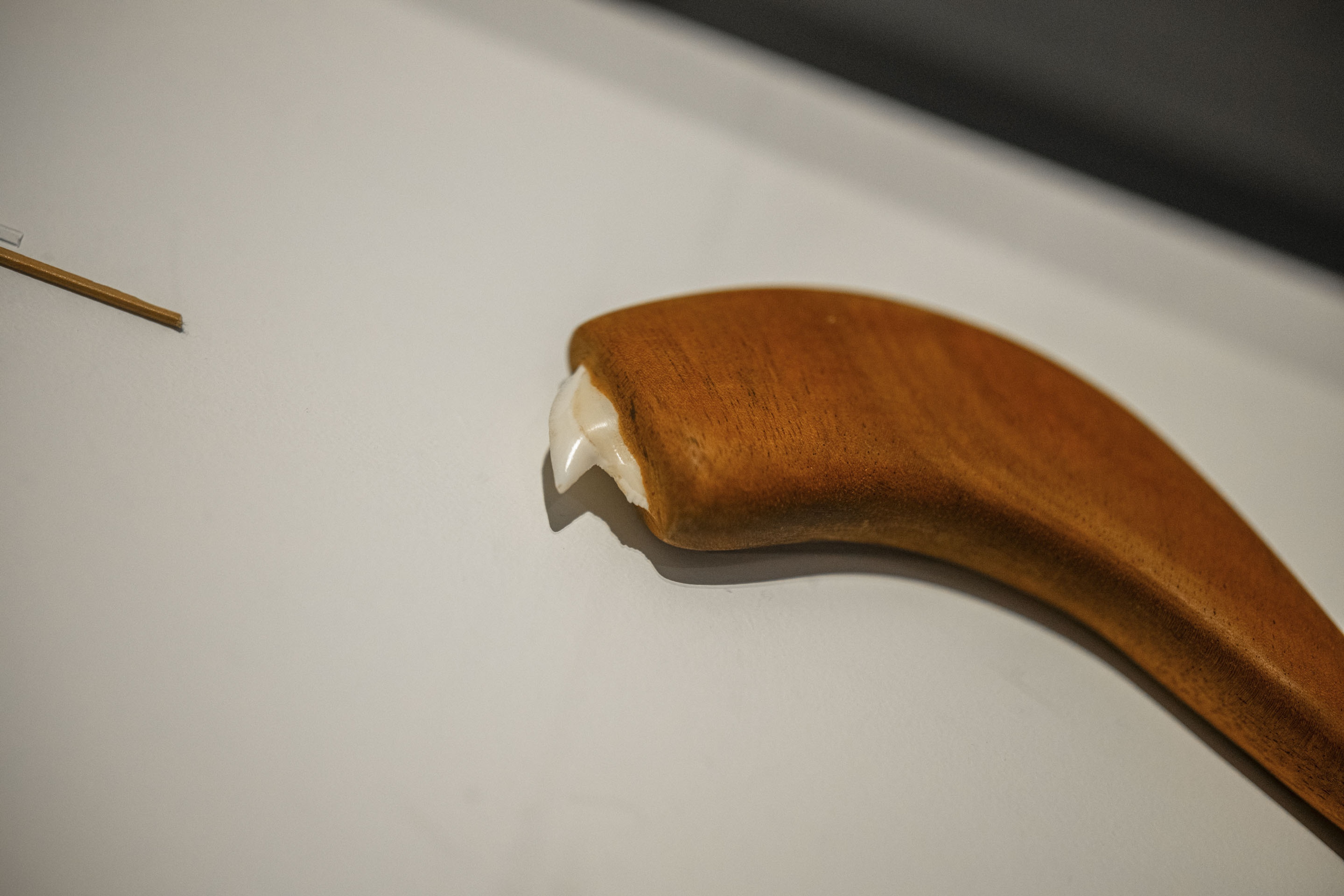
Dalani Tanahy, Niho mano (shark knife) (detail), 2021, Niho mano (tiger shark tooth), ohi‘a wood, 40 × 150 × 20mm. Collection of Museum of New Zealand Te Papa Tongarewa. Purchased 2022. Installation view, ’Ahu: Ngā Wairua o Hina, Vaiei Tupuna, Te Pātaka Toi Adam Art Gallery, Te Herenga Waka—Victoria University of Wellington, 2024. Photo: Ted Whitaker.

Installation view, ’Ahu: Ngā Wairua o Hina, Collection of Museum of New Zealand Te Papa Tongarewa. Commissioned 2023. Vaiei Tupuna, Te Pātaka Toi Adam Art Gallery, Te Herenga Waka—Victoria University of Wellington, 2024. Photo: Ted Whitaker.

Installation view, ’Ahu: Ngā Wairua o Hina, Collection of Museum of New Zealand Te Papa Tongarewa. Commissioned 2023. Vaiei Tupuna, Te Pātaka Toi Adam Art Gallery, Te Herenga Waka—Victoria University of Wellington, 2024. Photo: Ted Whitaker.

Cora-Allan, Ornate ike (tapa beater) (detail), 2021, pūriri, hiapo, pāua, kāpia ink, oil stain. Collection of Museum of New Zealand Te Papa Tongarewa. Purchased 2021. Installation view, ’Ahu: Ngā Wairua o Hina, Vaiei Tupuna, Te Pātaka Toi Adam Art Gallery, Te Herenga Waka—Victoria University of Wellington, 2024. Photo: Ted Whitaker.

Hinatea Colombani, Í'e (Tahitian tapa beater), 2023, wood, 40 × 40 × 375mm; and Tutua (Tahitian tapa beating anvil), 2023, wood, 569 × 125 × 105mm. Collection of Museum of New Zealand Te Papa Tongarewa. Purchased 2021. Installation view, ’Ahu: Ngā Wairua o Hina, Vaiei Tupuna, Te Pātaka Toi Adam Art Gallery, Te Herenga Waka—Victoria University of Wellington, 2024. Photo: Ted Whitaker.

Installation view, ’Ahu: Ngā Wairua o Hina, Collection of Museum of New Zealand Te Papa Tongarewa. Commissioned 2023. Vaiei Tupuna, Te Pātaka Toi Adam Art Gallery, Te Herenga Waka—Victoria University of Wellington, 2024. Photo: Ted Whitaker.

Sulieti Fieme’a Burrows, Tui Emma Gillies, Sarah Vaki, Tutana Tetuanui-Peters, Bundle wrap, 2023, ngatu (Tongan tapa), a’eu pipi (perfumed Marquesan tapa). Collection of Museum of New Zealand Te Papa Tongarewa. Commissioned 2023. Installation view, ’Ahu: Ngā Wairua o Hina, Vaiei Tupuna, Te Pātaka Toi Adam Art Gallery, Te Herenga Waka—Victoria University of Wellington, 2024. Photo: Ted Whitaker.

Sara Vaki, 2023. Collection of Museum of New Zealand Te Papa Tongarewa. Commissioned 2023.Installation view, ’Ahu: Ngā Wairua o Hina, Vaiei Tupuna, Te Pātaka Toi Adam Art Gallery, Te Herenga Waka—Victoria University of Wellington, 2024. Photo: Ted Whitaker.

Sara Vaki, Pou'u mei (Marquesan breadfruit tapa), September 2023, Mei (breadfruit), Collection of Museum of New Zealand Te Papa Tongarewa. Commissioned 2023.

Installation view, ’Ahu: Ngā Wairua o Hina, Collection of Museum of New Zealand Te Papa Tongarewa. Commissioned 2023. Vaiei Tupuna, Te Pātaka Toi Adam Art Gallery, Te Herenga Waka—Victoria University of Wellington, 2024. Photo: Ted Whitaker.

Hinatea Colombani, 2023. Collection of Museum of New Zealand Te Papa Tongarewa. Commissioned 2023.Installation view, ’Ahu: Ngā Wairua o Hina, Vaiei Tupuna, Te Pātaka Toi Adam Art Gallery, Te Herenga Waka—Victoria University of Wellington, 2024. Photo: Ted Whitaker.
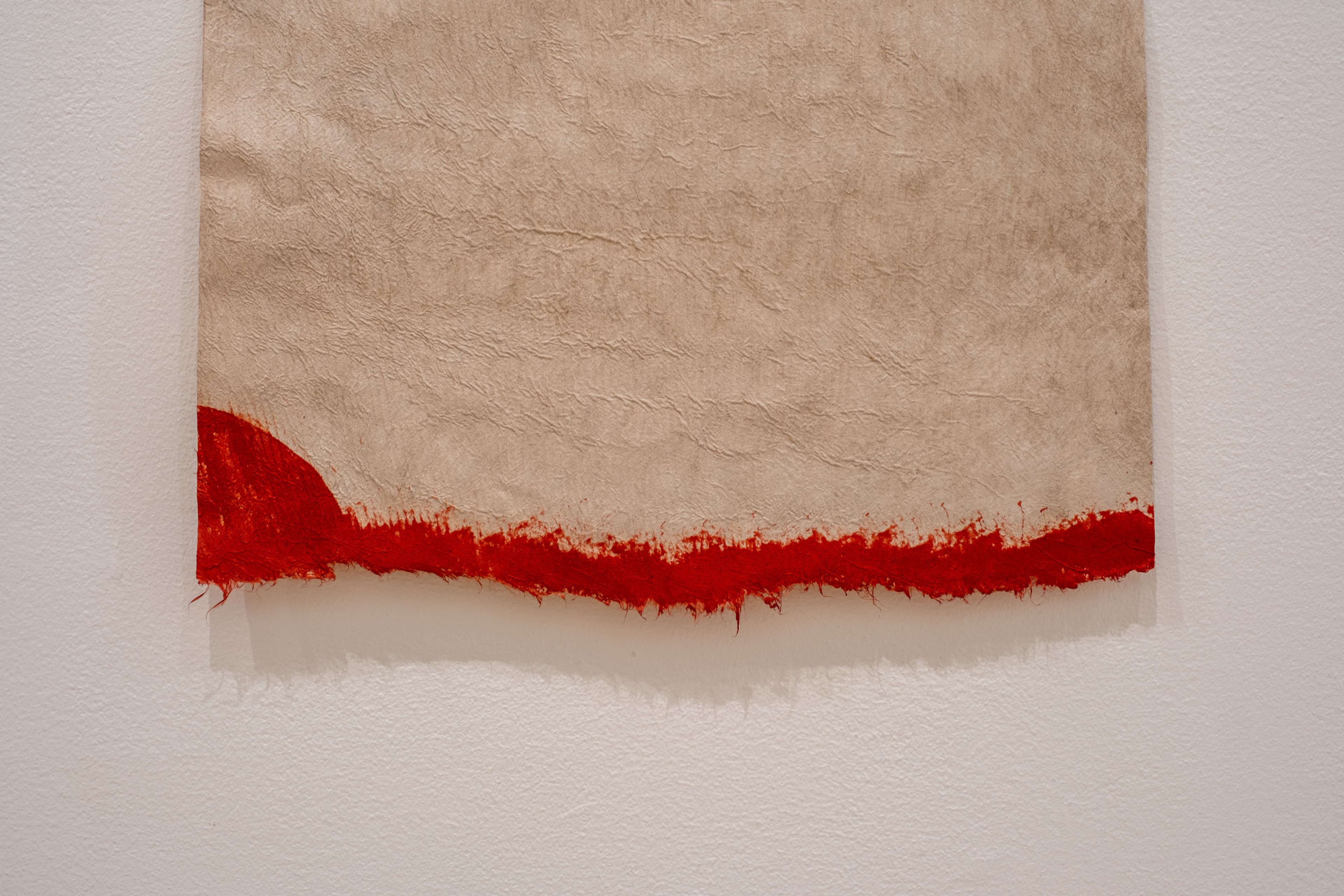
Hinatea Colombani, Tauāmuri (detail), 2023, ’aute (paper mulberry), mati (fuchsia), tou (Oceania walnut). Collection of Museum of New Zealand Te Papa Tongarewa. Commissioned 2023. Installation view, ’Ahu: Ngā Wairua o Hina, Vaiei Tupuna, Te Pātaka Toi Adam Art Gallery, Te Herenga Waka—Victoria University of Wellington, 2024. Photo: Ted Whitaker.

Pauline Reynolds, 2023. Collection of Museum of New Zealand Te Papa Tongarewa. Commissioned 2023. Installation view, ’Ahu: Ngā Wairua o Hina, Vaiei Tupuna, Te Pātaka Toi Adam Art Gallery, Te Herenga Waka—Victoria University of Wellington, 2024. Photo: Ted Whitaker.

Sue Pearson, 2023. Collection of Museum of New Zealand Te Papa Tongarewa. Commissioned 2023.Installation view, ’Ahu: Ngā Wairua o Hina, Vaiei Tupuna, Te Pātaka Toi Adam Art Gallery, Te Herenga Waka—Victoria University of Wellington, 2024. Photo: Ted Whitaker.

Sue Pearson, “Said Wi Es” - Where We Are, 2023, etching ink on 'ahu, Collection of Museum of New Zealand Te Papa Tongarewa, commissioned 2023.

Installation view, ’Ahu: Ngā Wairua o Hina, Collection of Museum of New Zealand Te Papa Tongarewa. Commissioned 2023. Vaiei Tupuna, Te Pātaka Toi Adam Art Gallery, Te Herenga Waka—Victoria University of Wellington, 2024. Photo: Ted Whitaker.

Dalani Tanahy, 2023. Collection of Museum of New Zealand Te Papa Tongarewa. Commissioned 2023. Installation view, ’Ahu: Ngā Wairua o Hina, Vaiei Tupuna, Te Pātaka Toi Adam Art Gallery, Te Herenga Waka—Victoria University of Wellington, 2024. Photo: Ted Whitaker.

Dalani Tanahy, Kupuna, 2023, natural pigment and cuttlefish ink wauke, Collection of Museum of New Zealand Te Papa Tongarewa, commissioned 2023.
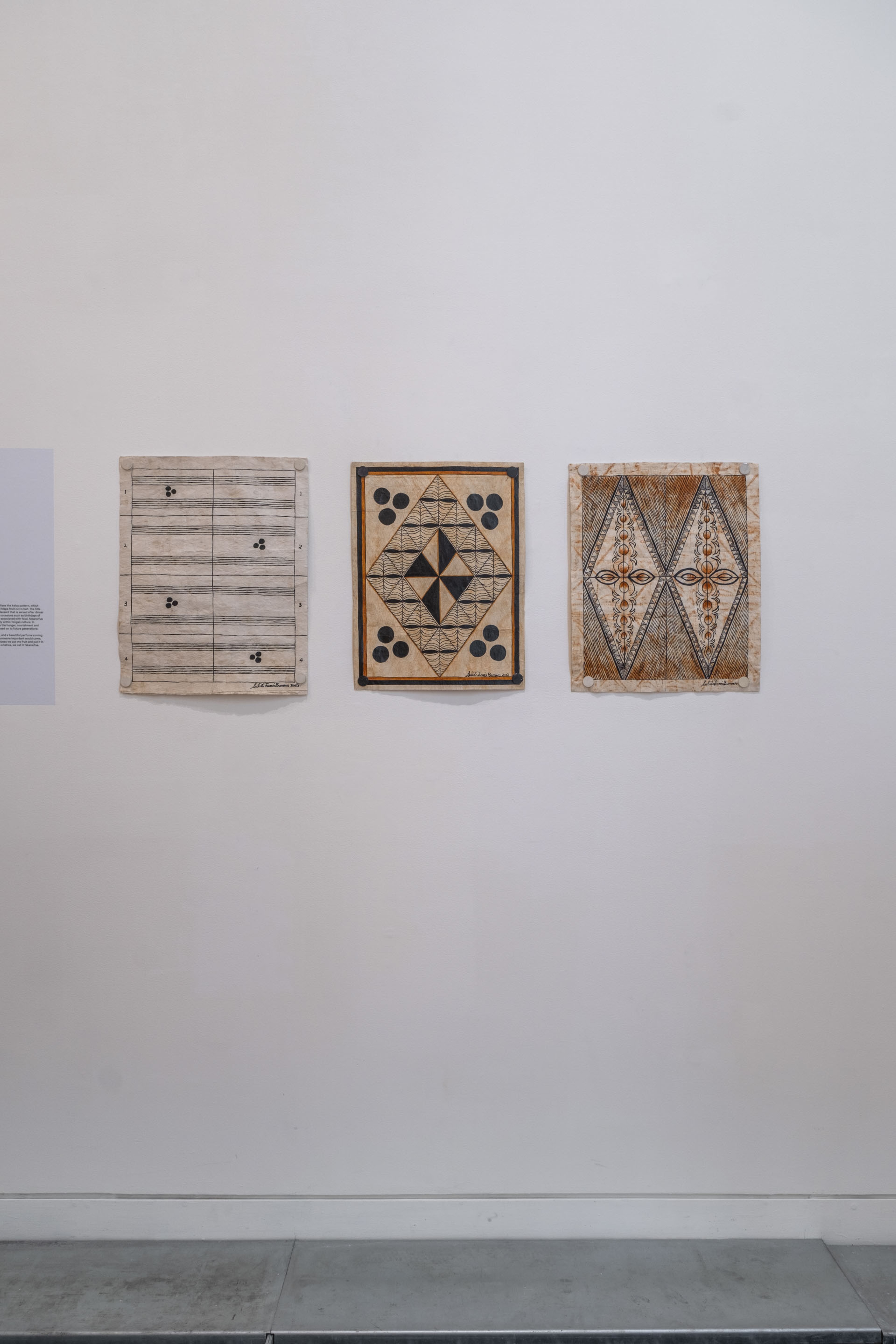
Sulieti Fieme’a Burrows, 2023.Collection of Museum of New Zealand Te Papa Tongarewa. Commissioned 2023. Installation view, ’Ahu: Ngā Wairua o Hina, Vaiei Tupuna, Te Pātaka Toi Adam Art Gallery, Te Herenga Waka—Victoria University of Wellington, 2024. Photo: Ted Whitaker.

Installation view, ’Ahu: Ngā Wairua o Hina, Vaiei Tupuna, Te Pātaka Toi Adam Art Gallery, Te Herenga Waka—Victoria University of Wellington, 2024. Photo: Ted Whitaker.
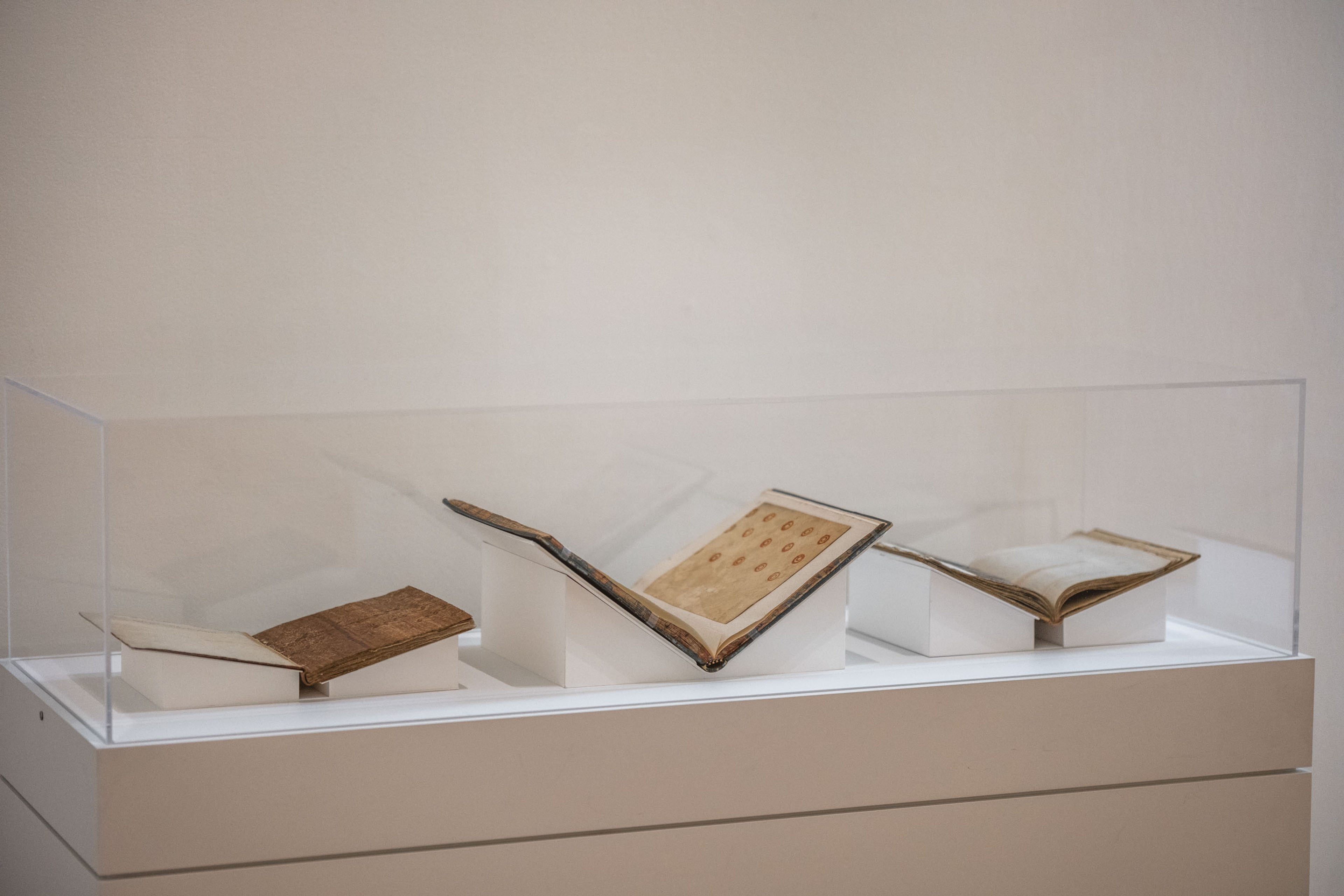
Installation view, ’Ahu: Ngā Wairua o Hina, Vaiei Tupuna, Te Pātaka Toi Adam Art Gallery, Te Herenga Waka—Victoria University of Wellington, 2024. Photo: Ted Whitaker.

Installation view, ’Ahu: Ngā Wairua o Hina, Vaiei Tupuna, Te Pātaka Toi Adam Art Gallery, Te Herenga Waka—Victoria University of Wellington, 2024. Photo: Ted Whitaker.

Alexander Shaw, [Catalogue of the Different Specimens of Cloth Collected in the three Voyages of Captain Cook], 1787, tapa cloth, paper. Collection of Museum of New Zealand Te Papa Tongarewa. Gift of the Te Papa Foundation 2021. Purchased with Charles Disney Art Trust funds. Installation view, ’Ahu: Ngā Wairua o Hina, Vaiei Tupuna, Te Pātaka Toi Adam Art Gallery, Te Herenga Waka—Victoria University of Wellington, 2024. Photo: Ted Whitaker.

Alexander Shaw, A catalogue of the different specimens of cloth collected in the three voyages of Captain Cook, 1787, 8 pages, 39 unnumbered mounted specimens of tapa cloth, interleaved with blank sheets of paper, 300mm. Collection of Ngā Pātaka Kōrero o Tāmaki Makaurau Auckland Council Libraries Heritage Collections. Installation view, ’Ahu: Ngā Wairua o Hina, Vaiei Tupuna, Te Pātaka Toi Adam Art Gallery, Te Herenga Waka—Victoria University of Wellington, 2024. Photo: Ted Whitaker.

Alexander Shaw, A catalogue of the different specimens of cloth collected in the three voyages of Captain Cook, to the southern hemisphere: with a particular account of the manner of manufacturing the same in the various islands of the south seas ; partly extracted from Mr. Anderson and Reinhold Forster’s observations, and the verbal account of some of the most knowing of the navigators : with some anecdotes that happened to them among the natives. (detail),1787, 8 p., [24 ] leaves of cloth samples. Collection of the Alexander Turnbull Library, Te Puna Mātauranga o Aotearoa National Library of New Zealand. Installation view, ’Ahu: Ngā Wairua o Hina, Vaiei Tupuna, Te Pātaka Toi Adam Art Gallery, Te Herenga Waka—Victoria University of Wellington, 2024. Photo: Ted Whitaker.

Liviana Qaranivalu, 2023. Collection of Museum of New Zealand Te Papa Tongarewa. Commissioned 2023. Installation view, ’Ahu: Ngā Wairua o Hina, Vaiei Tupuna, Te Pātaka Toi Adam Art Gallery, Te Herenga Waka—Victoria University of Wellington, 2024. Photo: Ted Whitaker.

Tui Emma Gillies, 2023. Collection of Museum of New Zealand Te Papa Tongarewa. Commissioned 2023. Installation view, ’Ahu: Ngā Wairua o Hina, Vaiei Tupuna, Te Pātaka Toi Adam Art Gallery, Te Herenga Waka—Victoria University of Wellington, 2024. Photo: Ted Whitaker.

Tui Emma Gillies, Feke, 2023, mixed media and natural pigment on ngatu sphere, Collection of Museum of New Zealand Te Papa Tongarewa, commissioned 2023.

Installation view, ’Ahu: Ngā Wairua o Hina, Collection of Museum of New Zealand Te Papa Tongarewa. Commissioned 2023. Vaiei Tupuna, Te Pātaka Toi Adam Art Gallery, Te Herenga Waka—Victoria University of Wellington, 2024. Photo: Ted Whitaker.
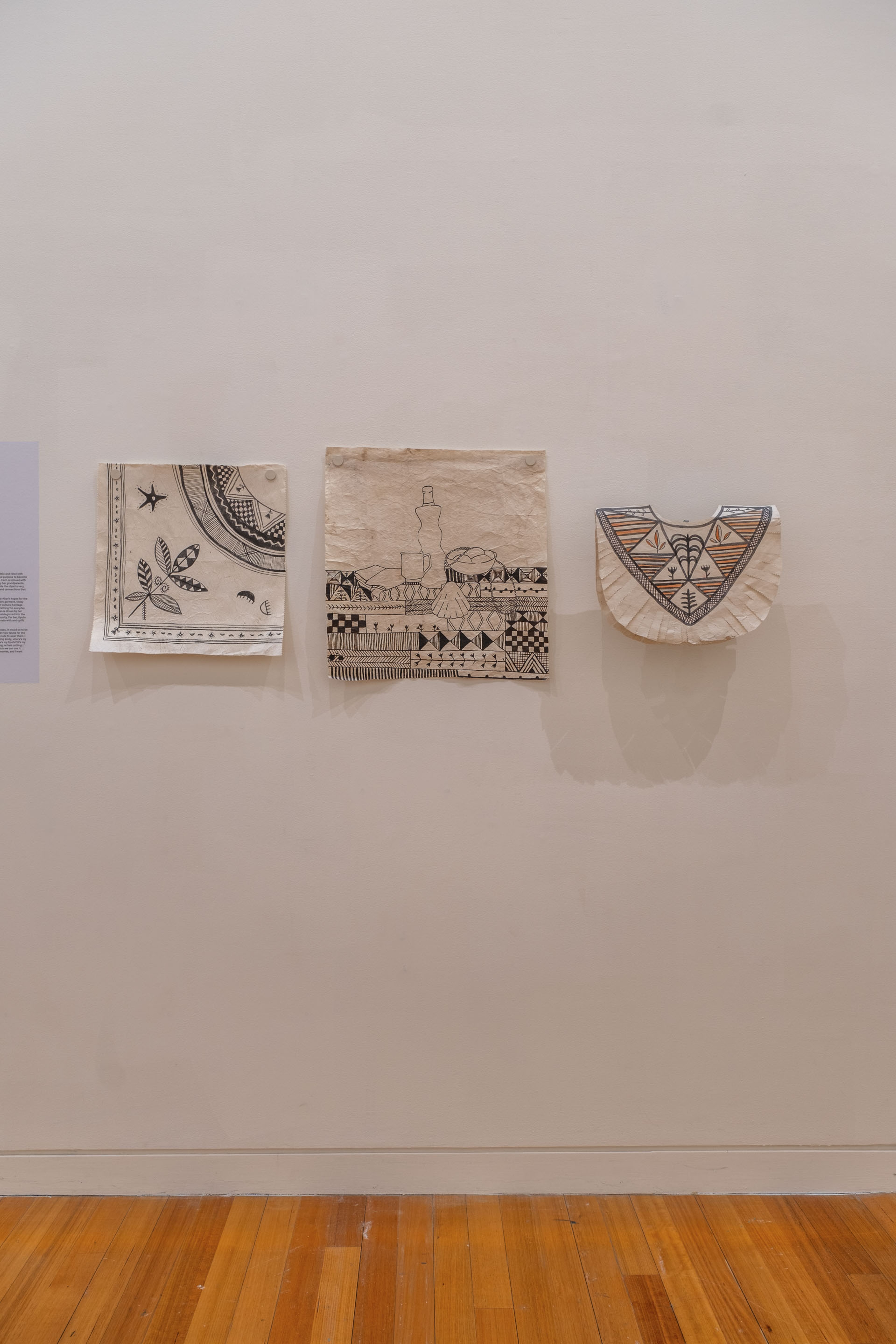
Cora-Allan, 2023. Collection of Museum of New Zealand Te Papa Tongarewa. Commissioned 2023. Installation view, ’Ahu: Ngā Wairua o Hina, Vaiei Tupuna, Te Pātaka Toi Adam Art Gallery, Te Herenga Waka—Victoria University of Wellington, 2024. Photo: Ted Whitaker.

Cora-Allan, Past, 2023, kāpia ink hiapo, Collection of Museum of New Zealand Te Papa Tongarewa, commissioned 2023.

Cora-Allan, Present, 2023, kāpia ink hiapo, Collection of Museum of New Zealand Te Papa Tongarewa, commissioned 2023.

Doron Semu, 2023. Collection of Museum of New Zealand Te Papa Tongarewa. Commissioned 2023. Installation view, ’Ahu: Ngā Wairua o Hina, Vaiei Tupuna, Te Pātaka Toi Adam Art Gallery, Te Herenga Waka—Victoria University of Wellington, 2024. Photo: Ted Whitaker.

Doron Semu, 2023. Collection of Museum of New Zealand Te Papa Tongarewa. Commissioned 2023. Installation view, ’Ahu: Ngā Wairua o Hina, Vaiei Tupuna, Te Pātaka Toi Adam Art Gallery, Te Herenga Waka—Victoria University of Wellington, 2024. Photo: Ted Whitaker.
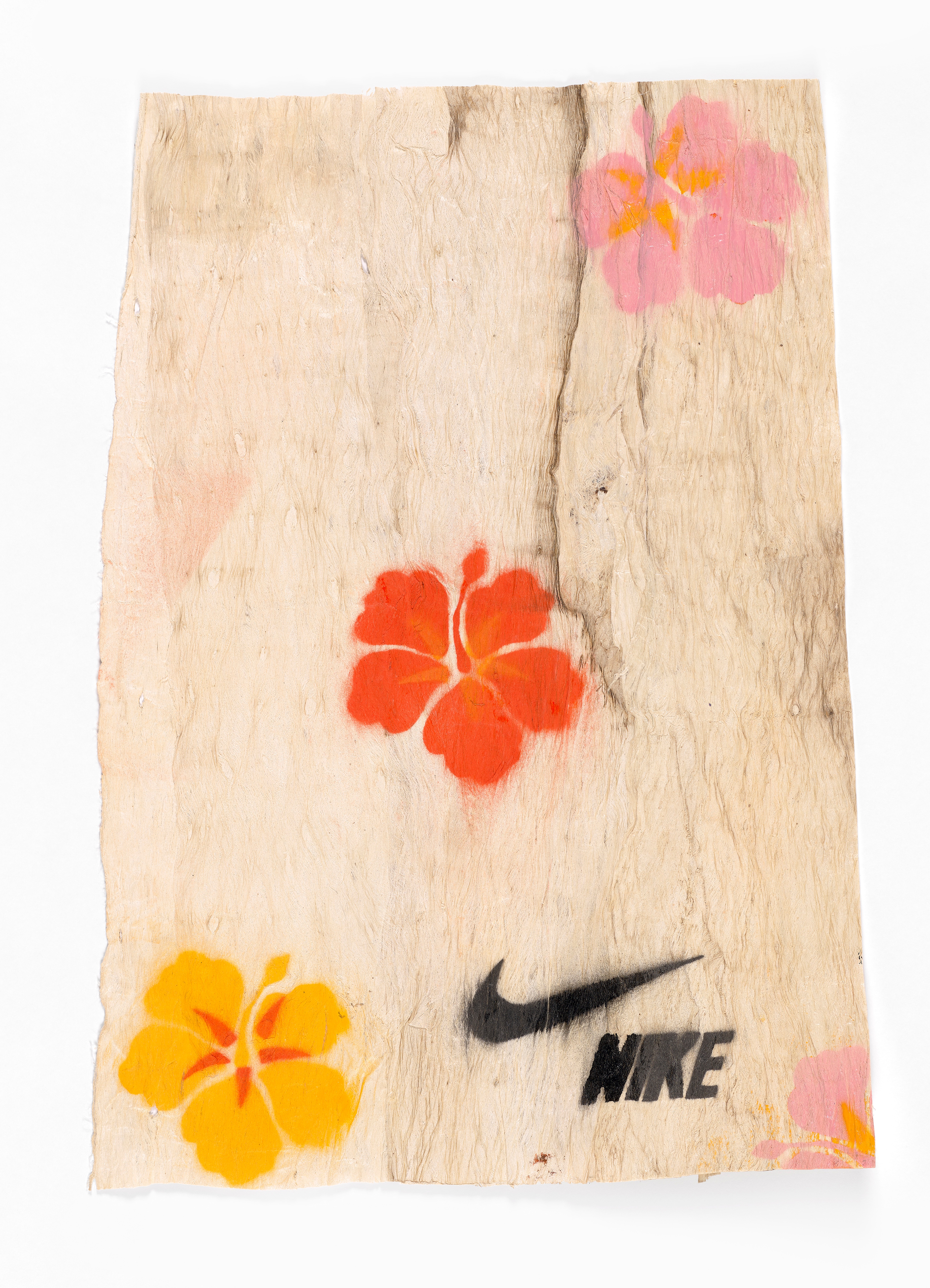
Doron Semu, Nike, (Fa’a masina), 2023, spray painted siapo, Collection of Museum of New Zealand Te Papa Tongarewa, commissioned 2023.

Installation view, ’Ahu: Ngā Wairua o Hina, Collection of Museum of New Zealand Te Papa Tongarewa. Commissioned 2023. Vaiei Tupuna, Te Pātaka Toi Adam Art Gallery, Te Herenga Waka—Victoria University of Wellington, 2024. Photo: Ted Whitaker.

Nikau Hindin, 2023. Collection of Museum of New Zealand Te Papa Tongarewa. Commissioned 2023. Installation view, ’Ahu: Ngā Wairua o Hina, Vaiei Tupuna, Te Pātaka Toi Adam Art Gallery, Te Herenga Waka—Victoria University of Wellington, 2024. Photo: Ted Whitaker.